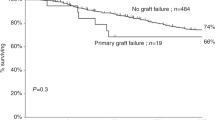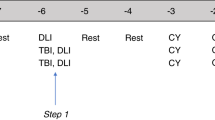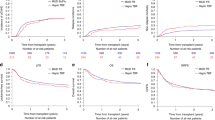Abstract
Graft failure is a fatal complication following allogeneic stem cell transplantation where a second transplantation is usually required for salvage. However, there are no recommended regimens for second transplantations for graft failure, especially in the haploidentical transplant setting. We recently reported encouraging outcomes using a novel method (haploidentical transplantation from a different donor after conditioning with fludarabine and cyclophosphamide). Herein, we report updated outcomes in 30 patients using this method. The median time of the second transplantation was 96.5 (33–215) days after the first transplantation. Except for one patient who died at +19d and before engraftment, neutrophil engraftments were achieved in all patients at 11 (8–24) days, while platelet engraftments were achieved in 22 (75.8%) patients at 17.5 (9–140) days. The 1-year OS and DFS were 60% and 53.3%, and CIR and TRM was 6.7% and 33.3%, respectively. Compared with the historical group, neutrophil engraftment (100% versus 58.5%, p < 0.001) and platelet engraftment (75.8% versus 32.3%, p < 0.001) were better in the novel regimen group, and OS was also improved (60.0% versus 26.4%, p = 0.011). In conclusion, salvage haploidentical transplantation from a different donor using the novel regimen represents a promising option to rescue patients with graft failure after the first haploidentical transplantation.
This is a preview of subscription content, access via your institution
Access options
Subscribe to this journal
Receive 12 print issues and online access
$259.00 per year
only $21.58 per issue
Buy this article
- Purchase on Springer Link
- Instant access to full article PDF
Prices may be subject to local taxes which are calculated during checkout

Similar content being viewed by others
Data availability
The data used to support the findings of this study are available from the corresponding author upon request.
References
Kharfan-Dabaja MA, Kumar A, Ayala E, Aljurf M, Nishihori T, Marsh R, et al. Standardizing definitions of hematopoietic recovery, graft rejection, graft failure, poor graft function, and donor chimerism in allogeneic hematopoietic cell transplantation: a report on behalf of the American Society for Transplantation and Cellular Therapy. Transplant Cell Ther. 2021;27:642–9.
Ozdemir ZN, Civriz Bozdag S. Graft failure after allogeneic hematopoietic stem cell transplantation. Transfus Apher Sci. 2018;57:163–7.
Alcazer V, Peffault de Latour R, Ader F, Labussiere-Wallet H. Graft failure after allogeneic hematopoietic stem cell transplantation: definition and risk factors. Bull Cancer. 2019;106:574–83.
Mattsson J, Ringden O, Storb R. Graft failure after allogeneic hematopoietic cell transplantation. Biol Blood Marrow Transplant. 2008;14:165–70.
Ferra C, Sanz J, Diaz-Perez MA, Morgades M, Gayoso J, Cabrera JR, et al. Outcome of graft failure after allogeneic stem cell transplant: study of 89 patients. Leuk Lymphoma. 2015;56:656–62.
Locatelli F, Lucarelli B, Merli P. Current and future approaches to treat graft failure after allogeneic hematopoietic stem cell transplantation. Expert Opin Pharmacother. 2014;15:23–36.
Nagler A, Labopin M, Swoboda R, Kulagin A, Velardi A, Sanz J, et al. Long-term outcome of second allogeneic hematopoietic stem cell transplantation (HSCT2) for primary graft failure in patients with acute leukemia in remission: a study on behalf of the Acute Leukemia Working Party of the European Society for Blood and Marrow Transplantation. Bone Marrow Transpl. 2023;58:1008–16.
Singh H, Nikiforow S, Li S, Ballen KK, Spitzer TR, Soiffer R, et al. Outcomes and management strategies for graft failure after umbilical cord blood transplantation. Am J Hematol. 2014;8912:1097–101.
Rondon G, Saliba RM, Khouri I, Giralt S, Chan K, Jabbour E, et al. Long-term follow-up of patients who experienced graft failure postallogeneic progenitor cell transplantation. Results of a single institution analysis. Biol Blood Marrow Transplant. 2008;14:859–66.
Sun Y, Xu L, Liu D, Zhang X, Wang Y, Han W, et al. Second transplantation for 22 patients with graft failure after first allogeneic stem cell transplantation. Zhonghua Xue Ye Xue Za Zhi. 2014;35:673–7.
Chen J, Pang A, Zhao Y, Liu L, Ma R, Wei J, et al. Primary graft failure following allogeneic hematopoietic stem cell transplantation: risk factors, treatment and outcomes. Hematology. 2022;271:293–9.
Olsson RF, Logan BR, Chaudhury S, Zhu X, Akpek G, Bolwell BJ, et al. Primary graft failure after myeloablative allogeneic hematopoietic cell transplantation for hematologic malignancies. Leukemia. 2015;29:1754–62.
Wang Y, Liu DH, Liu KY, Xu LP, Zhang XH, Han W, et al. Long-term follow-up of haploidentical hematopoietic stem cell transplantation without in vitro T cell depletion for the treatment of leukemia: nine years of experience at a single center. Cancer. 2013;119:978–85.
Aversa F, Terenzi A, Tabilio A, Falzetti F, Carotti A, Ballanti S, et al. Full haplotype-mismatched hematopoietic stem-cell transplantation: a phase II study in patients with acute leukemia at high risk of relapse. J Clin Oncol. 2005;23:3447–54.
Luznik L, O’Donnell PV, Symons HJ, Chen AR, Leffell MS, Zahurak M, et al. HLA-haploidentical bone marrow transplantation for hematologic malignancies using nonmyeloablative conditioning and high-dose, posttransplantation cyclophosphamide. Biol Blood Marrow Transplant. 2008;14:641–50.
Giammarco S, Raiola AM, Di Grazia C, Bregante S, Gualandi F, Varaldo R, et al. Second haploidentical stem cell transplantation for primary graft failure. Bone Marrow Transpl. 2021;56:1291–6.
Harada K, Najima Y, Kato M, Fuji S, Shinohara A, Nakamae H, et al. Outcomes of salvage haploidentical transplantation using posttransplant cyclophosphamide for graft failure following allogeneic hematopoietic stem cell transplantation. Int J Hematol. 2022;116:744–53.
Prata PH, Resche-Rigon M, Blaise D, Socie G, Rohrlich PS, Milpied N, et al. Outcomes of salvage haploidentical transplant with post-transplant cyclophosphamide for rescuing graft failure patients: a report on behalf of the Francophone Society of Bone Marrow Transplantation and Cellular Therapy. Biol Blood Marrow Transplant. 2019;25:1798–802.
Sun YQ, Wang Y, Wang FR, Yan CH, Cheng YF, Chen YH, et al. Graft failure in patients with hematological malignancies: a successful salvage with a second transplantation from a different haploidentical donor. Front Med. 2021;8:604085.
Konuma T, Harada K, Kondo T, Masuko M, Uchida N, Yano S, et al. Salvage single-unit unrelated cord blood transplantation for graft failure following initial allogeneic transplantation in adult acute myeloid leukemia: trends in outcomes over the past 20 years. Bone Marrow Transpl. 2022;57:1848–50.
Harada K, Fuji S, Seo S, Kanda J, Ueki T, Kimura F, et al. Comparison of the outcomes after haploidentical and cord blood salvage transplantations for graft failure following allogeneic hematopoietic stem cell transplantation. Bone Marrow Transpl. 2020;55:1784–95.
Wegener D, Lang P, Paulsen F, Weidner N, Zips D, Ebinger M, et al. Immunosuppressive total nodal irradiation-based reconditioning regimens after graft rejection or graft failure in pediatric patients treated with myeloablative allogeneic hematopoietic cell transplantation. Int J Radiat Oncol Biol Phys. 2019;104:137–43.
Kliman D, Bilmon I, Kwan J, Blyth E, Micklethwaite K, Panicker S, et al. Rescue haploidentical peripheral blood stem cell transplantation for engraftment failure: a single-centre case series. Intern Med J. 2018;48:988–91.
Guardiola P, Kuentz M, Garban F, Blaise D, Reiffers J, Attal M, et al. Second early allogeneic stem cell transplantations for graft failure in acute leukaemia, chronic myeloid leukaemia and aplastic anaemia. French Society of Bone Marrow Transplantation. Br J Haematol. 2000;111:292–302.
Teltschik HM, Heinzelmann F, Gruhn B, Feuchtinger T, Schlegel P, Schumm M, et al. Treatment of graft failure with TNI-based reconditioning and haploidentical stem cells in paediatric patients. Br J Haematol. 2016;175:115–22.
Huang XJ. Overcoming graft failure after haploidentical transplantation: is this a possibility? Best Pract Res Clin Haematol. 2021;34:101255.
Prabahran A, Koldej R, Chee L, Ritchie D. Clinical features, pathophysiology, and therapy of poor graft function post-allogeneic stem cell transplantation. Blood Adv. 2022;6:1947–59.
Acknowledgements
This work was partly supported by the National Natural Science Foundation of China (grant no. 8227010768) and the National Key Research and Development Program of China (2021YFC2500300).
Author information
Authors and Affiliations
Contributions
X-JH and Y-QS contributed to the study design, and RM and Y-QS wrote the manuscript. In addition, all authors provided clinical or biological data, reviewed, and approved the manuscript.
Corresponding author
Ethics declarations
Competing interests
The authors declare no competing interests.
Additional information
Publisher’s note Springer Nature remains neutral with regard to jurisdictional claims in published maps and institutional affiliations.
Supplementary information
Rights and permissions
Springer Nature or its licensor (e.g. a society or other partner) holds exclusive rights to this article under a publishing agreement with the author(s) or other rightsholder(s); author self-archiving of the accepted manuscript version of this article is solely governed by the terms of such publishing agreement and applicable law.
About this article
Cite this article
Ma, R., Zhu, DP., Zhang, XH. et al. Salvage haploidentical transplantation for graft failure after first haploidentical allogeneic stem cell transplantation: an updated experience. Bone Marrow Transplant (2024). https://doi.org/10.1038/s41409-024-02276-5
Received:
Revised:
Accepted:
Published:
DOI: https://doi.org/10.1038/s41409-024-02276-5



